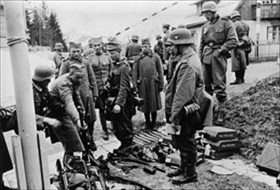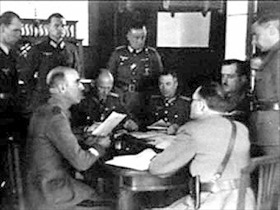GREEK ARMY CAPITULATES TO NAZI INVADERS
German 12th Army HQ, Larissa, Greece · April 21, 1941
On this date in 1941 representatives of the Greek government, leaderless after Prime Minister Alexandros Koryzis committed suicide three days earlier, signed a document of capitulation at the headquarters of the German 12th Army at Larissa. Fourteen Greek divisions laid down their arms. The news that Greece had surrendered to his Axis partner rather than to Italy infuriated Italian dictator Benito Mussolini. It was the Duce’s plan to dominate southeastern Europe that had triggered the Italian invasion of Greece from neighboring Albania almost six months earlier, on October 28, 1940, an invasion that took Adolf Hitler completely by surprise. That Hitler had to rescue Mussolini from a Greek quagmire of his own making was galling enough. Within days of invading Greece the Duce’s army was close to being defeated by inspired Greek military leadership and British arms (later men). In a meeting between Mussolini and Hitler in Bavaria on January 19–20, 1941, Hitler apprised his junior partner of Operation Marita, which assumed that Yugoslavia would join the Axis alliance (Tripartite Pact), allowing the German army to attack the Greek-British defense line from the rear that spring. After Yugoslav officers overthrew the government of the regent, Prince Paul, which had signed the Axis pact, and placed King Peter II on the throne, Hitler launched an invasion of Yugoslavia and Greece on April 6, 1941. Yugoslavs signed the act of surrender in their destroyed capital eleven days later. Hitler smoothed Mussolini’s feathers over Greece’s surrender to Germany by restaging the capitulation ceremony two days later in Thessaloniki with an Italian representative present. Two days later the British flew the Greek king and government to the island of Crete, the first step in creating a Greek government-in-exile. On April 27 German tanks entered Athens, and by month-end the Royal Navy had evacuated what it could (50,000) of the Allied expeditionary force. In their disastrous campaign in Greece, the Allies lost nearly 13,000 men, including 9,000 taken prisoner, and all of their heavy equipment. Mussolini’s army, in six months of campaigning, suffered over 76,000 casualties and 25,000 missing. Greek losses were close to 16,000 dead and missing and 300,000 taken prisoner. German casualties in both countries were under 5,500.
[amazon_carousel widget_type=”ASINList” width=”600″ height=”200″ title=”Recommended Reading” market_place=”US” shuffle_products=”False” show_border=”False” asin=”1936274299,1929631421,B005MR3RX8,1932455191,1477551891,098165259X,1889247014,0300089236,1105074013,1906033560″ /]
The Axis Conquest of Yugoslavia and Greece, April 1941
 |  |
Left: The German invasion of Yugoslavia began on April 6, 1941, with an overwhelming air attack on the Yugoslav capital, Belgrade, and attacks by German land forces initially from Bulgaria. This photo purports to show Yugoslav soldiers laying down their arms on the day of the invasion.
![]()
Right: A German Panzer IV medium tank advancing into Yugoslavia from Bulgaria. In February 1941 the Bulgarian General Staff had agreed to let German troops and equipment use their country as a staging area for Germany’s assault on Yugoslavia.
 |  |
Left: Restaging the official surrender of Greek forces to both the German and Italian commands after Mussolini had made a personal representation to Hitler. Thessaloniki, Greece, April 23, 1941.
![]()
Right: Greek forces lacked the equipment necessary to fight against German motorized divisions and were soon encircled and overwhelmed. This photo may show retreating or captured Greek soldiers.
The Axis Invasion of Yugoslavia and Greece, April 1941
![]()

 History buffs, there is good news! The Daily Chronicles of World War II is now available as an ebook for $4.99 on Amazon.com. Containing a year’s worth of dated entries from this website, the ebook brings the story of this tumultuous era to life in a compelling, authoritative, and succinct manner. Featuring inventive navigation aids, the ebook enables readers to instantly move forward or backward by month and date to different dated entries. Simple and elegant! Click
History buffs, there is good news! The Daily Chronicles of World War II is now available as an ebook for $4.99 on Amazon.com. Containing a year’s worth of dated entries from this website, the ebook brings the story of this tumultuous era to life in a compelling, authoritative, and succinct manner. Featuring inventive navigation aids, the ebook enables readers to instantly move forward or backward by month and date to different dated entries. Simple and elegant! Click 











